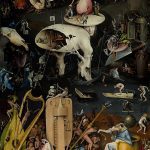

Hieronymus Bosch, the Dutch painter of the late 15th and early 16th centuries, remains one of art history’s most enigmatic and compelling figures. His surreal, chaotic works are filled with bizarre creatures, fantastical landscapes, and eerie narratives that seem to have emerged from the subconscious. Though his works often explore themes of sin, morality, and divine judgment, they also contain a playful absurdity that captivates viewers even centuries after their creation. Bosch’s ability to combine the grotesque and the humorous gives his art an enduring charm that appeals to lovers of the macabre and the whimsical alike.
The appeal of Bosch’s paintings lies in their complexity and richness of detail. Each piece is packed with intricate scenes that demand attention, pulling the viewer into an immersive world of strange discoveries. His paintings feel alive, as though they are unfolding their secrets in real time. This unique combination of surreal horror and engaging fun has cemented Bosch’s place as one of the most fascinating painters of the Western canon, inspiring both curiosity and awe.
While his works often leave viewers feeling unsettled, they also invite exploration and reflection. Bosch’s surreal and fantastical style predates the Surrealist movement by centuries, showing an uncanny understanding of the subconscious and dream logic. His paintings remain relevant and compelling not just because of their technical mastery, but because of their ability to provoke thought and spark the imagination.
A Feast for the Imagination: Bosch’s Chaotic Worlds
Bosch’s paintings are a sensory overload, filled with vivid details and surreal imagery that demand close inspection. One of his most famous works, The Garden of Earthly Delights, exemplifies his ability to create a world that feels simultaneously inviting and overwhelming. This triptych unfolds in three parts: the Garden of Eden, a fantastical depiction of Earth, and a horrifying vision of Hell. The central panel, in particular, is a riot of color and activity, with nude figures cavorting among oversized fruits, hybrid animals, and strange architectural structures. The sheer number of elements in the painting ensures that every viewing reveals something new.
Each tiny detail feels intentional, contributing to the chaotic yet harmonious whole. For instance, in The Garden of Earthly Delights, one can spot humans engaging in bizarre rituals, animals behaving like people, and objects used in impossible ways. A bird-headed figure balances precariously on a sphere, while a man hides inside a giant strawberry. These absurd details are both amusing and disorienting, pulling viewers deeper into Bosch’s surreal imagination. They invite speculation and interpretation, leaving viewers to ponder their symbolic meanings or simply enjoy their visual oddity.
Bosch’s ability to create such densely packed scenes makes his paintings feel alive. They are not static images, but dynamic worlds brimming with motion and narrative potential. Each corner of his canvases offers new surprises, turning the act of viewing into an adventure. This interactive quality is part of what makes his paintings so memorable and engaging, even for modern audiences accustomed to more straightforward storytelling. Bosch’s work rewards curiosity, encouraging viewers to linger and explore the endless possibilities of his strange universes.
The Horrors of Hell: Bosch’s Darker Imagination
While Bosch’s whimsical elements are entertaining, his depictions of Hell are where his imagination takes a darker, more unsettling turn. In the right panel of The Garden of Earthly Delights, Bosch presents a vision of eternal torment that is both grotesque and uniquely inventive. Here, sinners are subjected to bizarre punishments at the hands of monstrous creatures and surreal contraptions. Unlike traditional medieval depictions of Hell, which often relied on flames and demons, Bosch’s Hell is a landscape of personalized horrors. Each punishment feels tailored to the specific sins of its victims, adding a layer of psychological depth to the scene.
Bosch’s Hell is populated by grotesque hybrids of humans, animals, and objects, each more disturbing than the last. A bird-headed demon devours people whole, excreting them into a pit of despair, while another figure is fused with a musical instrument in an ironic punishment for vanity. These scenes feel alien yet strangely familiar, tapping into primal fears and anxieties. The surreal nature of these punishments makes them both horrifying and fascinating, as viewers are drawn to the sheer creativity and intricacy of Bosch’s vision.
Despite the darkness of these scenes, Bosch’s Hell is more than just a cautionary tale. It is a testament to his unparalleled creativity and his ability to translate abstract concepts like sin and judgment into vivid, unforgettable imagery. His Hellscapes are not merely warnings—they are immersive experiences that challenge viewers to confront their own fears and moral dilemmas. By blending horror with artistic brilliance, Bosch elevates his depictions of Hell into something deeply thought-provoking and uniquely his own.
The Humor Beneath the Horror
What sets Bosch apart from many other painters of his era is his ability to infuse even his darkest works with humor. While his depictions of Hell are undeniably horrifying, they are also filled with absurd details that invite laughter. Bosch seems to relish in the ridiculousness of his creations, turning punishments into exaggerated caricatures of human folly. This blend of horror and comedy creates a fascinating tension, making his paintings feel both unsettling and strangely delightful.
For example, in The Last Judgment, Bosch depicts sinners enduring wild and humiliating punishments. A man is swallowed whole by a fish, only to be spat out again, while another figure is trapped inside a giant egg. These scenes are undeniably grim, but their sheer inventiveness and absurdity make them oddly entertaining. Bosch’s exaggerated forms and surreal combinations of humans, animals, and objects often feel like visual jokes, softening the grimness of his moral message.
This humor prevents Bosch’s work from feeling overly bleak or didactic. Instead, it invites viewers to see themselves in the absurdity, laughing at the ridiculousness of human behavior even as they recognize its darker implications. Bosch’s playful approach to horror ensures that his works remain accessible and engaging, even for audiences unfamiliar with the religious context of his time. His ability to balance levity with gravity is part of what makes his paintings so endlessly fascinating.
A Precursor to Surrealism
Long before the Surrealist movement of the 20th century, Bosch was creating dreamlike works that blurred the lines between reality and fantasy. His creatures defy logic, combining elements of animals, humans, and objects into forms that feel simultaneously familiar and alien. Fish sprout wings, trees transform into humanoids, and people merge with mechanical contraptions in ways that seem to defy the laws of nature. This dream logic gives Bosch’s art a timeless quality, making it feel as relevant and compelling today as it did centuries ago.
Artists like Salvador Dalí and Max Ernst have cited Bosch as a major influence, and it’s easy to see why. His ability to tap into the subconscious and create otherworldly scenes paved the way for Surrealism, showing how art could explore the boundaries of imagination. Bosch’s works are not constrained by the rules of the physical world, allowing him to craft visions that feel like pure expressions of creativity. This freedom is part of what makes his paintings so thrilling—and so unsettling.
Bosch’s surreal elements resonate with modern audiences because they speak to universal human experiences, like dreams, fears, and the unknown. His ability to capture these abstract ideas in vivid, tangible forms ensures that his art remains relevant across cultures and centuries. By combining technical skill with boundless imagination, Bosch created works that transcend time, continuing to inspire and captivate viewers to this day.







